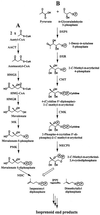Isoprenoid biosynthesis: the evolution of two ancient and distinct pathways across genomes
- PMID: 11078528
- PMCID: PMC27197
- DOI: 10.1073/pnas.240454797
Isoprenoid biosynthesis: the evolution of two ancient and distinct pathways across genomes
Abstract
Isopentenyl diphosphate (IPP) is the central intermediate in the biosynthesis of isoprenoids, the most ancient and diverse class of natural products. Two distinct routes of IPP biosynthesis occur in nature: the mevalonate pathway and the recently discovered deoxyxylulose 5-phosphate (DXP) pathway. The evolutionary history of the enzymes involved in both routes and the phylogenetic distribution of their genes across genomes suggest that the mevalonate pathway is germane to archaebacteria, that the DXP pathway is germane to eubacteria, and that eukaryotes have inherited their genes for IPP biosynthesis from prokaryotes. The occurrence of genes specific to the DXP pathway is restricted to plastid-bearing eukaryotes, indicating that these genes were acquired from the cyanobacterial ancestor of plastids. However, the individual phylogenies of these genes, with only one exception, do not provide evidence for a specific affinity between the plant genes and their cyanobacterial homologues. The results suggest that lateral gene transfer between eubacteria subsequent to the origin of plastids has played a major role in the evolution of this pathway.
Figures


References
-
- Summons R E, Jahnke L L, Hope J M, Logan G A. Nature (London) 1999;400:554–557. - PubMed
-
- Brocks J J, Logan G A, Buick R, Summons R E. Science. 1999;285:1033–1036. - PubMed
-
- Buckingham J. Dictionary of Natural Products on CD-ROM. London: Chapman & Hall; 1998. , Version 6.1.
-
- Spurgeon S L, Porter J W. In: Biosynthesis of Isoprenoid Compounds. Porter J W, Spurgeon S L, editors. Vol. 1. New York: Wiley; 1981. pp. 1–46.
Publication types
MeSH terms
Substances
LinkOut - more resources
Full Text Sources
Other Literature Sources
Medical

